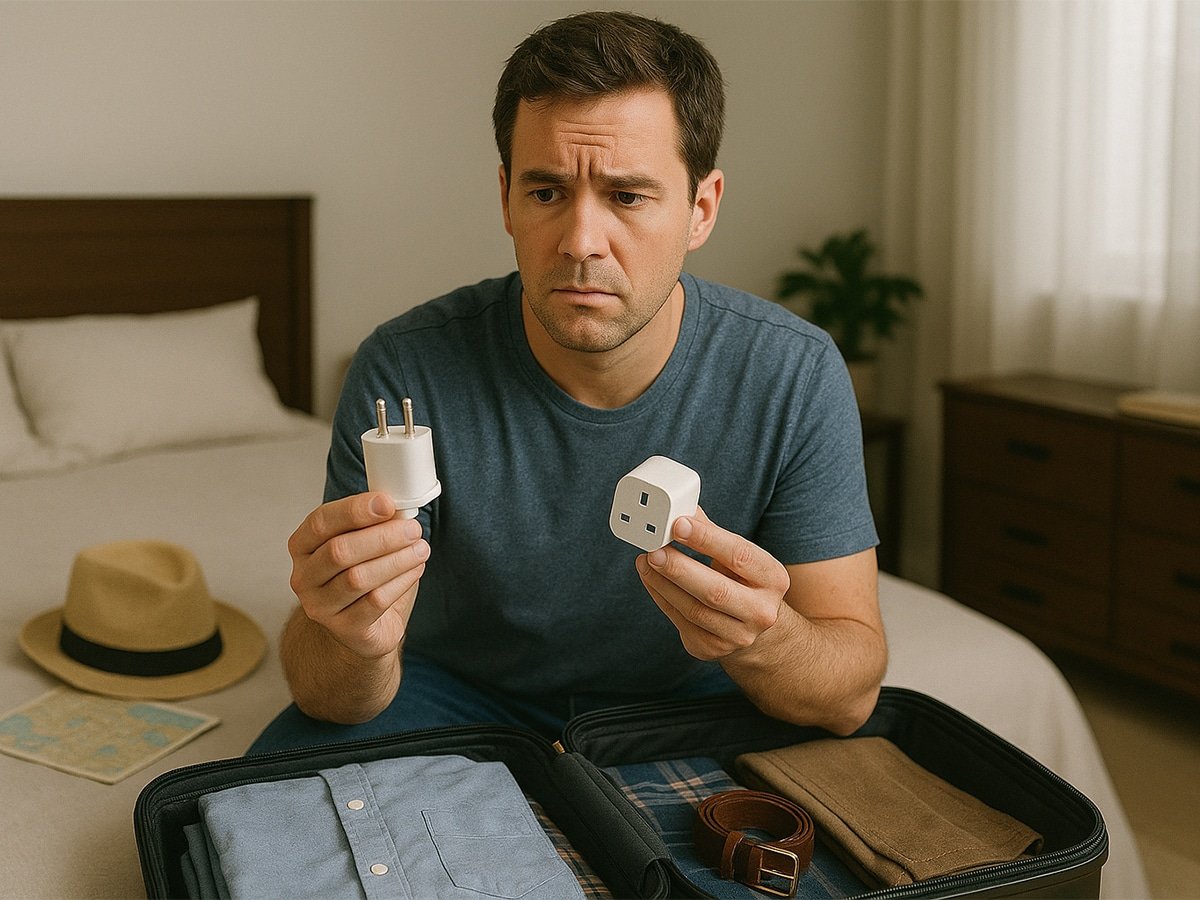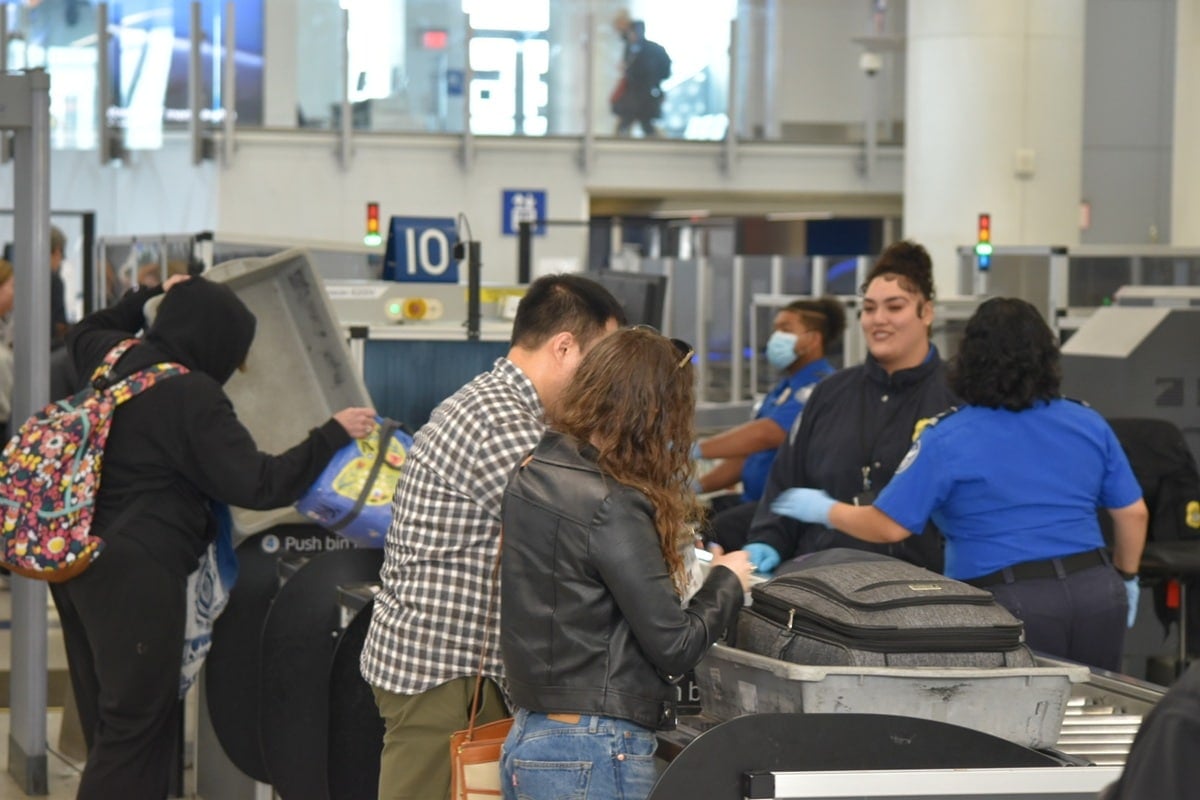This post contains references to products from one or more of our advertisers. We may receive compensation when you click on links to those products. For an explanation of our Advertising Disclosure, visit this page.
Summer is around the corner and with it comes the buzz of international travel plans. According to a survey conducted by Bankrate, 46 percent of U.S. adults are planning to travel this summer. If you are among them and are getting ready to pack your bags, don’t forget to think about how to charge your electronics abroad without frying them.

If you’ve ever stared at your curling iron or phone charger and wondered, “Do I need a travel adapter or a converter for this thing?”… you’re not alone. And if you’ve ever seen sparks fly from your flat iron because you used an adapter instead of a converter, then you know what an inconvenience it is to fry a much-needed device while traveling.
Here’s how to pack smart and power up safely, no matter where you go.
Travel Adapter vs. Converter
Here’s the golden rule: Adapters change the shape of your plug. Converters change the voltage.
- Travel Adapter: This little gadget lets your plug physically fit into a different country’s outlet. It doesn’t change the electrical voltage, just the plug shape.
- Voltage Converter (or Transformer): This device changes the actual voltage coming from the outlet to match what your device needs. Essential for certain electronics that aren’t dual voltage.
Why Voltage Matters
Different countries run on different voltages:
- North America: 110–120V
- Most of Europe, Asia and Africa: 220–240V
If your device can’t handle a higher voltage and you plug it directly into a 220V outlet, you could fry it instantly. That’s where a converter comes in.
But good news: Most modern electronics like phone chargers, laptops and cameras are dual voltage. Look at the fine print on the charger or plug. If it says something like “Input: 100–240V,” you’re safe to use it abroad with just an adapter.
Devices That Usually Just Need a Travel Adapter
These are typically dual voltage and can handle 100–240V, so they just need the right plug adapter:
- Phones
- Tablets
- Laptops
- E-readers
- Camera battery chargers
- Electric toothbrushes (many models)
Of course, always doublecheck your device specifically so you know whether it’s single or dual voltage.
Devices That Often Need a Converter
These are usually single voltage and designed for North America’s 110V:
- Hair dryers
- Curling irons
- Hair straighteners
- Electric shavers
- Older devices without USB charging
Unless your hair tools specifically say “dual voltage,” you’ll likely need a converter or better yet, buy a dual-voltage version or use hotel-provided ones.
Plug Types Around the World
There are 15 types of plugs used around the world, but here are the most common:
- Type A/B: North America, Japan
- Type C/E/F: Most of Europe
- Type G: UK, Ireland, Singapore
- Type I: Australia, New Zealand, China
- Type D/M: India, Nepal, some African countries
Rather than buying a single-country adapter, a universal travel adapter is your best bet. Look for one with USB ports and surge protection. Or consider the Apple World Travel Adapter Kit. It is designed to work with iPod, iPhone, iPad and Mac notebooks. It is compatible with Apple USB-C Power Adapters, MagSafe and MagSafe 2 Power Adapters, 10W, 12W, 30 and 35W USB Power Adapters, and Portable Power Adapters. The AC plugs included in the World Travel Adapter Kit directly support outlets in North America, Japan, China, United Kingdom, Continental Europe, Korea, Australia, Hong Kong and Brazil.
What to Pack: A Quick Cheat Sheet

Pro Tips for Packing Smart
- Check your device labels. Look for “100–240V” input. If it’s there, you’re good with just an adapter.
- Bring a power strip. Plug your adapter into the wall and connect all your devices through the strip: One adapter, many gadgets.
- Invest in a universal adapter. Save space and cover every country in one tool.
- Buy hair tools abroad or go heat-free. Converters for high-heat appliances can be bulky and unreliable.
Recommended Must-Haves:
- Universal Travel Adapter with multiple USB ports
- Surge protector (or adapter with built-in surge protection)
- Voltage converter (only if you must bring single-voltage appliances)
- Portable power bank for on-the-go charging
When it comes to international travel adapters and converters, the trick is knowing your devices and your destination. With the right set-up, you can stay powered up across the globe without any sparks flying.
So, before you zip up your suitcase, double-check your plugs, voltages and devices. A little planning goes a long way and keeps your electronics (and your hair) safe.
KEEP READING
–How to save money with a secret third carry-on
–How to use your wireless headphones to watch in-flight movies
–10 airport security hacks every traveler should know
–How to get the best coach seat on the plane
–The sleep hack every traveler needs to know
Want more travel news, tips and deals? Sign up to Johnny Jet’s free newsletter and check out these popular posts: The Travel Gadget Flight Attendants Never Leave Home Without and 12 Ways to Save Money on Baggage Fees. Follow Johnny Jet on MSN, Facebook, Instagram, Pinterest, and YouTube for all of my travel posts.




I would stay away from converters. It’s too easy to fry hair tools. Converters are not strong enough to make the conversion in all products. It is much better to purchase hair tools that work with both 110 & 220v. This way you can travel with ease, knowing that you only have to change the plug end. It is not hard to find most dual voltage hair tools. Hair dryers will take a little longer to find but you can get them.
Just returned from Sicily where the travel adapters I used for previous visits to France DID NOT FIT most Italian sockets. Most Italian sockets are Type L and need a fractionally different plug from the French Type C/E.